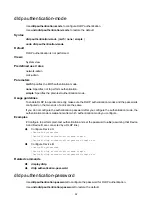
66
[Sysname-Vlan-interface10] vrrp version 2
vrrp vrid authentication-mode
Use
vrrp vrid authentication-mode
to configure the authentication mode and the authentication
key for an IPv4 VRRP group to send and receive VRRP packets.
Use
undo
vrrp vrid authentication-mode
to restore the default.
Syntax
vrrp vrid
virtual-router-id
authentication-mode
{
md5
|
simple
} {
cipher
|
plain
}
key
undo vrrp vrid
virtual-router-id
authentication-mode
Default
Authentication is disabled when a VRRP group sends and receives VRRP packets.
Views
Interface view
Predefined user roles
network-admin
mdc-admin
Parameters
virtual-router-id
: Specifies an IPv4 VRRP group by its virtual router ID in the range of 1 to 255.
md5
: Specifies the MD5 authentication mode.
simple
: Specifies the simple authentication mode.
cipher
: Sets a ciphertext authentication key.
plain
: Sets a plaintext authentication key.
key
: Sets the authentication key. This argument is case sensitive. It must be a ciphertext string of 1 to
41 characters if the
cipher
keyword is specified or a plaintext string of 1 to 8 characters if the
plain
keyword is specified.
Usage guidelines
To avoid attacks from unauthorized users, VRRP member routers add authentication keys in VRRP
packets to authenticate one another. VRRP provides the following authentication modes:
•
simple
—Simple text authentication.
The sender fills an authentication key into the VRRP packet, and the receiver compares the
received authentication key with its local authentication key. If the two authentication keys are
the same, the received VRRP packet is legitimate. Otherwise, the received packet is
illegitimate.
•
md5
—MD5 authentication.
The sender computes a digest for the packet to be sent by using the authentication key and
MD5 algorithm, and it saves the result in the authentication header. The receiver performs the
same operation by using the authentication key and MD5 algorithm, and it compares the result
with the content in the authentication header. If the results are the same, the received VRRP
packet is legitimate. Otherwise, the received packet is illegitimate.
The MD5 authentication is more secure than the simple text authentication, but it costs more
resources.
For security purposes, all keys, including keys configured in plain text, are saved in cipher text.






























